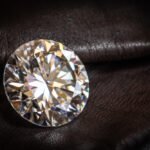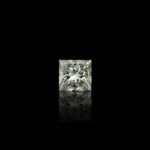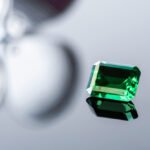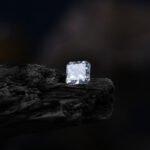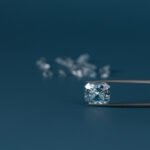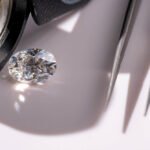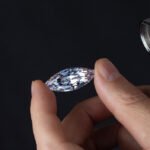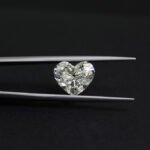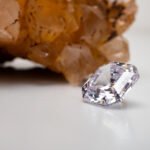EDUCATION
Strengthening the basics
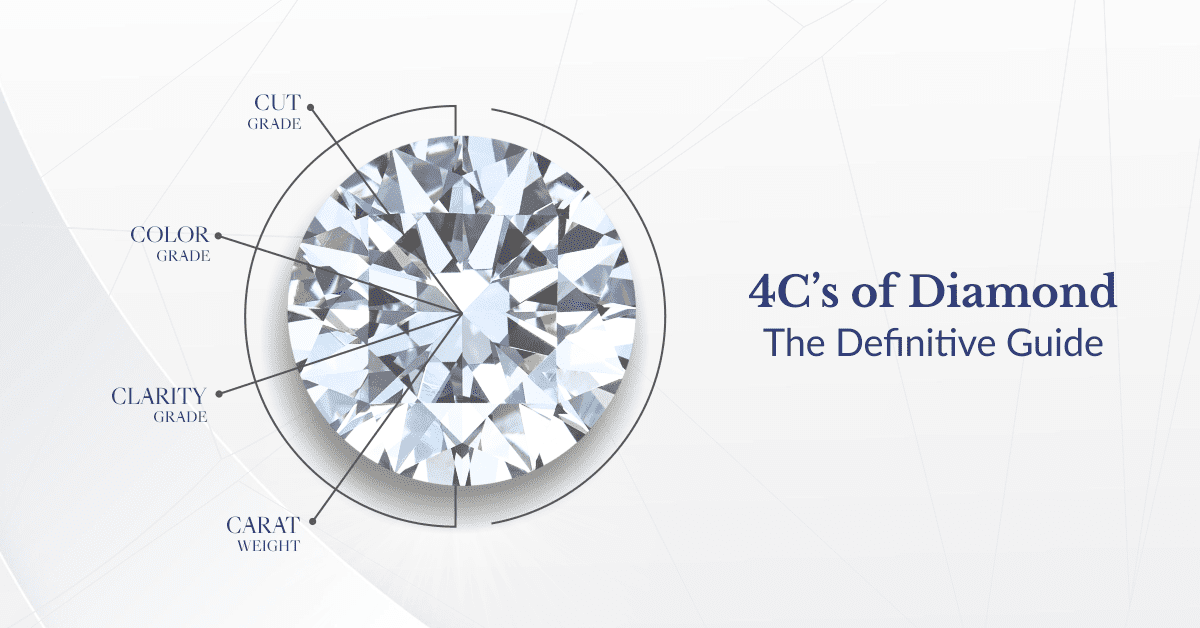
HISTORY OF DIAMONDS?
Stones to stud of shine
The diamond is more than just aesthetically beautiful-it’s an enduring symbol of love, romance, and commitment. The stone’s name is derived from the Greek word ‘adamas’, which translates to “unconquerable”. This symbolic meaning lends itself well to the diamond’s historic commemoration of eternal love.
The earliest diamonds were found in India in 4th century BC, although the youngest of these deposits were formed 900 million years ago. A majority of these early stones were transported along the network of trade routes that connected India and China, commonly known as the Silk Road. At the time of their discovery, diamonds were valued because of their strength and brilliance, and for their ability to refract light and engrave metal. Diamonds were worn as adornments, used as cutting tools, served as a talisman to ward off evil, and were believed to provide protection in battle. In the Dark Ages, diamonds were also used as a medical aid and were thought to cure illness and heal wounds when ingested. Diamonds are made up of 100% carbon. Diamonds are created when carbon is subjected to the extremely high pressures and temperatures found at the earth’s lithosphere, which lies approximately 90-240 miles below the earth’s surface. Until the 18th century, India was thought to be the only source of diamonds. When the Indian diamond mines were depleted, the quest for alternate sources began. Although a small deposit was found in Brazil in 1725, the supply was not enough to meet world demands. In 1866, 15-year-old Erasmus Jacobs was exploring the banks of the Orange River when he came across what he thought was an ordinary pebble, but turned out to be a 21.25-carat diamond. In 1871, a colossal 83.50-carat deposit was unearthed on a shallow hill called Colesberg Kopje. These findings sparked a rush of thousands of diamond prospectors to the region and led to the opening of the first large-scale mining operation which came to be known as the Kimberly Mine. This newly discovered diamond source increased the world’s diamond supply substantially, resulting in a significant decrease in their value. The elite no longer considered the diamond a rarity, and began to replace this “common” stone with colored gemstones. Emeralds, rubies, and sapphires became more popular choices for engagement ring stones among the upper class.
In 1880, Englishman Cecil John Rhodes formed De Beers Consolidated Mines, Ltd in an effort to control the diamond supply. Although DeBeers was successful in their efforts to control the supply of diamonds, demand for the stone was weak. By 1919, diamonds were devalued by nearly 50%. In 1947, DeBeers commissioned the services of leading advertising agency N.W. Ayer, and the slogan “A Diamond is Forever” was coined. The premise of this large-scale marketing campaign was the suggestion that diamonds should be the only choice for engagement rings. The DeBeers advertising campaign was wildly successful, and was a contributing factor to today’s widespread embracing of the tradition of diamond engagement rings. In today’s fine jewelry market, more than 78% of engagement rings sold contain diamonds.
With the surge in popularity of the precious stone, many companies and organizations began campaigns to educate jewelers and consumers about what to look for when selecting a diamond. As jewelers experimented with ways to enhance the diamond’s visual appeal and presentation, new cutting techniques were adopted to help increase the stone’s brilliance. Over time, several prominent shapes emerged as the most popular varieties, including Round, Oval, Marquise, Princess, and Emerald.Today, the world’s diamond deposits are slowly becoming depleted. Less than 20% of the diamonds mined are of gem quality; less than 2% are considered “investment diamonds”. 75-80% of mined diamonds are used for industrial applications, such as grinding, sawing, and drilling. Typically, more than 250 tons of ore must be mined in order to produce a one-carat, gem-quality stone. The diamond’s rarity, beauty, and strength make it a fitting symbol of the resilience and longevity of marriage. In addition to engagement rings, diamonds are traditionally given as gifts to commemorate the milestone of the sixtieth anniversary. With their rich history, sense of permanence, and lustrous brilliance, diamonds are a natural choice to signify a lasting union.
4C's OF DIAMONDS
All you need to know about diamonds
Because diamonds are so valuable, it’s essential to have a universal grading system for comparing their quality. Until the middle of the twentieth century, there was no agreed-upon standard by which diamonds could be judged. In the 1940s and ’50s, GIA created the first, and now globally accepted standard for describing diamonds:
The 4Cs. GIA developed the 4Cs and the GIA International Diamond Grading System to objectively compare and evaluate diamonds. The four characteristics that determine the value of a diamond are Color, Clarity, Carat weight, and Cut. Keep in mind that a single large diamond is more expensive than several smaller stones with the same qualities. This is due to the fact that larger diamonds are harder to find. The creation of the diamond 4Cs meant two very important things: diamond quality could be communicated in a universal language, and diamond customers could now know exactly what they were about to purchase. Today, the 4Cs of diamond quality is the universal method for assessing the quality of any diamond, anywhere in the world.
DIAMOND CERTIFICATION
A certificate of perfection
A diamond certificate, also called a diamond grading report, diamond dossier, or diamond quality document, is an official report created by a team of gemologists of a specific diamond grading laboratory.
During the certification process, the diamond is evaluated, measured, and scrutinized using trained eyes, a jeweler’s loupe, a microscope, and other industry tools. A completed certificate includes an analysis of the diamond’s dimensions, clarity, color, polish, symmetry, and other individual characteristics. Many round diamonds will also include a cut grade on the report. A diamond certificate is a very useful tool for identifying a stone. Although diamonds have been sought after and admired for thousands of years, only at the beginning of the 20th century did chemistry and other sciences advance to the point that objective, scientific grading of diamonds and other gemstones was made possible. The oldest gemological organization is the Gemological Institute of America, or GIA, founded in 1931 in Los Angeles, California..Since the GIA’s founding, other organizations have been created to meet rising worldwide demand for diamond certification. These include: AGS (American Gemological Society), HRD (Hoge Raad Voor Diamant; Diamond High Council), PGS (Professional Gem Sciences), EGL (European Gemological Institute) and the IGI (International Gemological Institute). Each of these labs follow a precise criteria and method of grading loose diamonds, all operating within a high set of parameters, in regards to grading a diamond’s attributes and dimensions. The laboratory that is held in the highest regard by the diamond industry is the Gemological Institute of America. GIA’s standards for grading have set the bar for all other gemological laboratories, making it the most trusted and respected name in gemological laboratories.
DIAMOND FACTS
did you know?
- Diamonds form about 100 miles below the surface of the Earth, in the molten rock of the earth’s core.
- Diamonds are the hardest material on earth : 58 times. harder than anything else in nature.
- Most diamonds are between 1 to 3 billion years old.
- In order for a diamond to be created, a pressure of 435,113 pounds per square inch must be placed on carbon at a temperature of over 750 degrees.
- Almost 85% of the world’s diamonds are not suitable for use as jewelry.
- The average yield in most diamond mines is 1 part diamond to 1 million parts host rock.
- Diamond is the only gem composed of one single element: carbon.
- An estimated 5 million people have access to appropriate healthcare globally thanks to revenues from diamonds.
- The revenue from diamonds is instrumental in the fight against the HIV/AIDS pandemic.
- Approximately one million people are employed by the diamond industry in India.
- An estimated 65% of the world’s diamonds come from African countries.
- Diamond revenues enable every child in Botswana to receive free education up to the age of 13.
- Conflict diamonds have been reduced from approximately 4% to considerably less than 1% since the implementation of the Kimberley Process in 2003.
- In July 2000, the global diamond industry announced its zero-tolerance policy towards conflict diamonds and continues to drive this policy.
GLOSSARY
words that made lesser sense
Abrasion – A blemish, such as small nicks along the facet junctions.
A blemish, such as small nicks along the facet junctions (look whiter than the rest of the diamond), caused by impact damage. Excessive abrading often a sign that the stone is cubic zirconium, not diamond.
AGS – American Gem Society – One of the leading gemological labs.
While DiamondWhisperer grades to GIA standards, AGS is quite close to GIA on grading standards.
See an exmaple of a AGS grading report .
Appraisal – An estimation of value of an item, typically for insurance purposes.
While this might be a good guide for the layman, appraisals are rarely, if ever, up to GIA standards for grading purposes. Furthermore, appraisals provide an indication, usually exaggerated, of the retail replacement value of an item, not the re-sale value.
Artificially Irradiated– See Irradiated Diamond.
Asscher Cut – See Shape.
Baguette – See Shape.
Bearded Girdle – Small hairline fractures running from the girdle into the gemstone. Also known as “bearding”.
Bezel – The large facets (second to the table) on the crown of a diamond.
Black Pique – The black inclusions visible within a diamond.
These are more detrimental to the diamond’s value than white (or clear) imperfections. Despite this, a diamond grading report will often treat white and black inclusions the same for clarity grading purposes.
Blemish – An imperfection on the surface of a diamond.
A diamond can be internally flawless (IF), even if it has blemishes, including scratches, nicks and abrasions. Blemishes can usually be easily removed by polishing.
Bow Tie Effect – A dark shadow shaped like a bow tie.
This effect is evident in some cuts of fancy shaped diamonds, such as ovals and marquises. This is detrimental to the value of the diamond, but not significantly.
Brilliance – Also called Brightness.
Brilliance is the effect of all the reflections of white light, both within and external to the diamond. The degree of brightness displayed is correlated to the diamond’s cut grade. A diamond exhibiting a high level of brightness will attain a very good or Excellent cut grade, for example. Whereas, a diamond exhibiting low brightness would probably attain a Poor cut.
Brilliant Cut – The optimal cut of a diamond so as to provide maximum brilliance.
A round brilliant has 57 or 58 facets (including the culet). Many fancy shapes have brilliant versions, including the cushion modified brilliant, the square modified brilliant (also known as the princess cut) and marquise brilliant.
Bruise – An inclusion (of small cracks or feathers) at, or near, the surface of a diamond.
These are more detrimental to the diamond’s value than white (or clear) imperfections. Despite this, a diamond grading report will often treat white and black inclusions the same for clarity grading purposes.
Canary diamonds – a common term used to describe a yellow diamond.
However, it is not a technical term that you will see on a GIA (or any other lab’s) grading report. GIA uses terms, such as fancy light yellow, fancy yellow, fancy intense yellow and fancy vivid yellow, among others.
Cape diamonds – generally within the range of M to Z on the color grading scale.
Again, this is not a technical term used on GIA grading reports.
Carat weight – the measure of weight of a diamond.
It should not be confused with karat (the measure of the purity of gold). The name Carat is derived from the carob seed, which, given its fairly uniform size, was used hundreds of years ago to weigh diamonds and other precious stones. Given the imprecise nature of this measure of weight, a standardized measure of the carat was developed and is now the standard world wide weight measure for diamonds. A carat is equal to 0.2 grams.
Carbon Spots – common term for black or dark inclusions in a diamond.
The technical name for them is black pique. Black pique are more detrimental to a diamond’s value than white or clear imperfections, as they are often more eye visible.
Cavity – An open imperfection in a diamond.
Certificate – Some labs refer to their grading reports as certificates.
They are often laminated (for longevity and to prevent tampering) and provide written documentation of the diamond’s natural occurrence, weight, proportions, color grade, clarity grade, cut grade, and other characteristics and qualities of the diamond, including any treatments.
Chip – an inclusion on the surface of the diamond where a piece of the diamond has broken off.
This can be quite detrimental to the value of the diamond, as the diamond needs re-cutting to return it to its original state. This can lead to the diamond ‘breaking its weight’ (going below important or magic weight levels, such a 1.00 cts).
Clarity – a diamonds relative lack of clarity characteristics.
Inclusions (fully enclosed within the diamond) and blemishes (surface imperfections) determine clarity. A clarity grade is determined by the overall effect of the clarity characteristics. Specifically, the size, number, position, nature and relief of the characteristics are all factors.
Dead – a diamond showing no lustre or brilliance as a result of heavy inclusions.
A diamond showing no lustre or brilliance as a result of heavy inclusions (often clouds) can be described as dead. A dead stone holds far less value than a “clean” or lightly included diamond of similar proportions.
Depth –the height of the diamond.
Measured from the top of the table to the bottom of the pavilion or culet.
Depth Percentage – depth (height) of the diamond divided by diameter (or average width).
Diamond – an allotrope of carbon (chemical symbol C).
he hardness natural material known to man (10 on the Mohs hardness scale), diamond is also an excellent conductor of heat and, as such, is used in the manufacture of semi-conductors.
Diamond Gauge – also known as a “leverage gauge”.
his instrument measures a diamond’s proportions to a 100th of a millimeter.
Diamond Grading Report – If you have a GIA, EGL USA or IGI grading report or certificate, then you can be almost certain you have a diamond. Certificates have been known to be forged, however.
Diamond or Fake? – an inclusion on the surface of the diamond where a piece of the diamond has broken off.
This can be quite detrimental to the value of the diamond, as the diamond needs re-cutting to return it to its original state. This can lead to the diamond ‘breaking its weight’ (going below important or magic weight levels, such a 1.00 cts).
There are several ways to test a diamond:
| Use a diamond tester – this apparatus uses heat to see if the stone is diamond. Diamond dissipates heat very quickly, so this tool is very quick and effective; | |
| The “Dot” test – draw a dot on a piece of paper and place a loose diamond (table down, culet up) on the dot. If the dot is clear (visible), the stone is most likely a simulant, such as CZ. A diamond refracts the light and thus the dot should not be visible. Please note that some baguettes and marquises may still show the dot due to it | |
| Wear test – Diamonds are very strong and only wear or abrade when they clash with other diamonds. Simulants, such as CZ, on the other hand, are softer and abrade more easily. So, if you have a very worn stone (lots of little nicks and chip, especially around the culet and on the pavilion facets (leading down to the culet), then the chances are you have a stimulant. | |
| The “flash” test – again, with a loose stone, as you pivot the stone under light, the pavilion (underside) might flash orange over most facets (synthetic cubic zirconia) or blue and violet (yttrium aluminium garnet) | |
| Doubling” – when viewed under 10x magnification, synthetic moissanite, synthetic rutile and zircon will show “doubling.” As you look through the table and rock the stone, the pavilion facet edges (underneath) and the culet will appear double (i.e. there are two of each of them). Diamonds are singly refractive, while moissanite is doubly refractive. |
EGL – European Gemological Laboratory or EGL is a privately owned, for-profit, gemological lab.
EGL has numerous labs around the world. We have found that their grading differs from that of GIA.
EGL-USA –EGL USA split from EGL and became independently owned in 1986.
It has labs in New York, Los Angeles, Vancouver and Toronto. We have found that their grading differs from that of GIA. See an example of a EGL USA report.
Emerald Cut– See Shape.
Etch Channels – angled openings (inclusions) at the surface, which protrude into the diamond.
Extra Facet – sometimes, the cutter will add an extra facet.
Sometimes, the cutter will add an extra facet (so, there are 59 on a round brilliant, for example) often around the girdle, in order to remove an inclusion. While this is not optimal, an extra facet does not necessarily reduce the value of the diamond. The size, positioning and effect of the extra facet on the diamond’s symmetry will determine any variance in the value.
Eye-Clean – When a diamond has no inclusions visible to the naked eye.
Typically, when the diamond is of SI quality or better.
Facet – The plane surfaces of a diamond created by diamond polishing.
Round brilliant cut diamonds have 57 or 58 facets (with a culet), for example.
Faceted Girdle – a girdle produced with approximately 32 small flat planes.
Fancy Color – the color of the diamond, other than white (D to Z on the color grading scale).
Fancy colors include fancy yellow, fancy red, fancy blue, fancy green and fancy pink, among others. Fancy color diamonds are typically worth more than those diamonds in the D to Z color range, with blues, greens and reds worth more than any others.
Fancy Shape – fancy shaped diamonds refer to all diamonds that are not round.
These include, but not limited to emerald cuts, cushions, radiants, Asscher cuts, ovals, marquises, pears and princess cuts.
Feather – an internal inclusion that appears like a small white feather.
A feather affects the clarity grade and, thus, the diamond’s value.
Finish – the final detailing or finish of a diamond is comprised of polish and symmetry.
Polish is the overall condition of the diamond’s surface. Symmetry is the exactness of the shape and placement of the facets.
Fire – it is evident when white light is dispersed into its spectral colors.
Diamonds with larger tables tend to show less fire. However, the right combination of lower girdle facet length, crown angle and pavilion angle can still result in a fairly high level of fire.
Fisheye – the dark reflection of the girdle within a shallow diamond.
Poorly cut diamonds (i.e. not deep enough) are worth less than a well proportioned diamond of a similar weight, color and clarity.
Flaw – an inclusion, such as a blemish, fracture or cavity.
Flawless – a diamond with no inclusions.
Fluorescence – The light emitted by approximately diamonds when exposed to ultraviolet light.
If the fluorescence is strong, it can make the diamond look cloudy and thus lowers the value. For diamonds with a color of J or lower (K, L, M, etc.), fluorescence is not seen as detrimental to the appearance or value.
GIA (The Gemological Institute of America) – the foremost gemological lab
Diamond Whisperer grades its diamonds based on GIA standards. See an example of a GIA grading report.
Girdle -The (usually) narrow area between the crown and pavilion.
The (usually) narrow area between the crown and pavilion on the perimeter of the diamond. The girdle can be as thin as “Extremely thin,” which can be an area of weakness on the diamond, or as thick as “Extremely Thick.”
Grading – How (& by whom) the diamond is graded?
Gemological labs, appraisers and independent gemologists grade diamonds and often provide a certificate or report for that diamond showing the size, shape, color, clarity and other characteristics. Unfortunately, these labs and appraisers each have their own ideas of color, clarity and some other characteristics. As such, a D color, VS2 from one lab could well be graded as an F color SI2 by another lab, or vice versa. This can result in a 50% swing in the value.
Diamond Whisperer grades all diamonds based on the GIA’s (Gemological Institute of America) standards. GIA is a non-profit organization and the foremost industry expert in grading diamonds. Importantly, we feel they are the most consistent grader and are considered within the diamond industry as being the pre-eminent graders. As such, Diamond Whisperer is able to offer consistent pricing across the diamonds we value as we can rely on the grading.
Download the GIA Diamond Grading Report Podcast
So, what if your diamond is graded by another lab? Is it graded incorrectly?Not necessarily. We have found that some other labs are more generous with their grading than GIA, but this is not always the case. We will always review your diamond before giving a final valuation, so you will know for sure what diamond you have.
Graining – lines or curves that appear whitish, colored or reflective.
hese lines are caused by irregularities in the crystal growth.
Hardness – the measurement of resistance to permanent deformations.
On the Mohs hardness scale, the hardness of a diamond is a 10, the hardest rating of all.
Heart Cut – See Shape.
HPHT – High Pressure High Temperature treatment process. See Color Enhancement.
HRD – Belgian-based certification lab.
Hue – the basic impression of a color; the aspect that gives color its identity.
In colored diamonds, a lab might give a diamond one or two or three color grades. For example, a diamond might be a fancy yellowish, brownish orange. The latter color is the most dominant hue and the one that affects the value the most.
I1 and I2 – Included clarity grades (I1 and I2).
See Clarity.
IF – Internally flawless clarity grade (only very minor surface inclusions allowed).
IGI – International Gemological Institute.
A privately-owned gemological lab with offices in Antwerp, Dubai, Hong Kong, Los Angeles, Mumbai, New York, Tel Aviv, Tokyo, and Toronto, among other cities.
Imperfection – A generic term used by non-gemologists for inclusions or blemishes.
Inclusion – an internal clarity characteristic in a diamond
hese include crystals, needles, pinpoints, clouds, graining, twinning wisp, laser drill holes. The more inclusions your diamond has, the lower the clarity grade and the lower the value, especially if laser drill holes are present. Inclusions can also extend into the diamond from the surface. These include bearded girdles, bruises, cavities, chips, feathers, indented naturals and knots.
Internal Graining – See Graining.
Irradiated Diamond – a diamond exposed to radiation to alter its color to a fancy color.
This is accomplished using neutron or electron bombardment. While irradiating a diamond might improve the color, it is an enhancement technique and consequently, has a negative impact on value. The GIA will specify on a grading report if the diamond has been irradiated.
Knot – a transparent crystal that extends to the surface of a diamond.
Laser Drill Hole – A hole made in a diamond by laser drilling.
This technique is used to reach a black pique in order to bleach it (with acid) and improve the look and clarity of the stone. However, as this is a treatment, it materially (negatively) impacts the value of the diamonds.
Laser Inscription – labs inscribe the grading report or certificate number on a diamond’s girdle.
Using a laser, labs can inscribe the grading report or certificate number (or client reference) on a diamond’s girdle. This has no impact on the diamond’s value, but makes it easier to identify the diamond.
Lizard Skin – wavy area on the surface of the diamond (that looks like lizard skin!)
Loupe – a small, handheld magnifying glass used to view diamonds.
A 10x loupe is standard, but other powers are available (14x, 20x, etc.)
Lower Girdle Facet – Triangular facets just below the girdle.
Luster – the quality of shining by reflecting light from the surface of a diamond.
Irradiated Diamond – a diamond exposed to radiation to alter its color to a fancy color.
Make – See Cut.
Marquise Cut – See Shape.
Melee – small diamonds of less than 0.20 cts used in jewelry.
Melee can be used to frame a center stone (pavé setting) or used on its own.
Natural – Also known as Indented Natural.
A natural is an inclusion that extends into the diamond from the surface. The natural can be a portion of the original surface (or skin) of the diamond (rough) or an opening left when a surface-reaching crystal is worked during polishing.
Needle – A thin, elongated crystal inclusion, which literally looks like a needle.
Nick – A small notch on a facet junction (usually on the girdle or culet).
Oval Cut – See Shape.
Painting & Digging – a polishing technique to change the angles of the upper & lower girdle facets.
This technique maximizes the weight yield from the diamond rough. Significant painting can retain 3% of the diamond’s weight, which might be important if you are close to the 1 ct mark. In addition, digging out can remove clarity characteristics (inclusions).
Pattern arrangement and contrast of the bright and dark areas of the diamond.
This results from light reflections.
Pavilion – The underside of the diamond between the girdle and the culet.
Pavilion Angle – the angle formed by the plane of the pavilion facets and the girdle.
Pear Cut – See Shape.
Pinpoints – very small crystals that look like dots under 10x magnification.
They are certainly not eye visible.
Pit – a small opening that looks like a tiny white dot.
Point – one one-hundredth of a carat (1/100th).
Polish – The overall condition of the diamond’s surface.
Diamond can take a better polish than any other gemstone, due to its hardness. However, as result of this hardness, diamond has to be polished with another diamond. Polish is graded on a scale of Excellent to Poor and each tick down in grade (caused by abrasions, nicks, scratches, etc.) reduces the value of the diamond.
Polish Lines – Fine, parallel grooves and ridges remaining after the polishing process.
Heavy polish lines emanating from a cavity or other surface inclusion are known as drag lines.
Princess Cut– See Shape.
Radiant Cut – See Shape.
Rough Diamond – a diamond that has not been cut and polished.
Round Brilliant Cut – See Shape.
Scintillation – A combination of the sparkle and pattern of a diamond.
Sparkle is the appearance of spots of light that flash as the diamond moves. Pattern is the arrangement and contrast of the bright and dark areas of the diamond resulting from light reflections.
Scratch – a thin, dull, white line on the diamond’s surface.
Can be removed by re-polishing, but the diamond might lose a little weight.
Shape – diamonds are cut into numerous shapes, with the most popular being round brilliant.
Also referred to as fancy cuts, shapes include round, marquise, cushion, emerald cut, pear, heart, trillion, radiant, princess cut, Asscher, oval, Old European cut, old mine cut, baguette, half moon, among others.
What diamond do you have?
SI – clarity grade of slightly included (SI1 and SI2).
Sparkle – the appearance of spots of light that flash as the diamond moves.
Surface Graining – See Graining
Symmetry – Symmetry is the exactness of the shape and placement of the facets.
A diamond should look symmetrical. It should be round (as opposed to off-round), the table should be in the middle of the crown (i.e. you should see equal amounts of the pavilion each side of the culet when viewing the diamond through the table), the culet should be in the middle of the table (i.e. the culet should be centered on the pavilion), the girdle should be flat (as opposed to being wavy), among other symmetries.
Synthetic Diamond– a man-made diamond created to simulate a diamond.
It’s created by using high pressure high temperature (HPHT) or lab grown using chemical vapor deposition (CVD) process. GIA and other labs can determine whether a diamond is natural or synthetic.
Table – the large facet at the top of the diamond.
Sparkle is the appearance of spots of light that flash as the diamond moves. Pattern is the arrangement and contrast of the bright and dark areas of the diamond resulting from light reflections.
Table Percentage –
For a round brilliant cut, the average width of the table as a percentage of the average diameter of the diamond. For fancy shapes, it is the width of the table as a percentage of the width of the entire diamond.
Treated Diamond – a diamond that has been altered to affect color or clarity.
See Irradiated Diamond and Color Enhancement.
Trillion Cut – See Shape.
Twinning Wisp –a series of pinpoints and/or clouds that form in the diamond’s growth plane.
This is a clarity characteristics that negatively impacts the diamond’s value.
Value – Retail value versus wholesale value.
Let’s get straight to the heart of the valuation issue. You or the purchaser of your ring may have paid retail price for the diamond, but that is now, unfortunately, a “sunk cost”. The retail price is markedly higher than the wholesale price, sometimes multiples of the price for some diamond jewelry, especially if it is from a high end brand. Add to this the other mark-ups in the chain…and you have a significant differential between the price you paid for the piece and its resale value now.
A good analogy is driving a new car off the lot; your purchase no longer holds the same value. With diamonds, it’s even less…
That being said, if you bought it many years ago, you might have more than recouped the difference. Diamond prices can rise significantly during boom years, so if you timed the purchase right, your assets could even have appreciated in value.
VS – clarity grade of Very Slightly Included (VS1 and VS2).
VVS – clarity grade of Very Slightly Included (VVS1 and VVS2).

